Table of Contents:
- Introduction to the 68RFE Transmission
- In this Drivetrain 101, we will be addressing
- Chrysler 68RFE Transmission Product Resources
- Popular Transmission Information Resources
- A Brief History of the 68RFE Transmission
- How the 68RFE Transmission Clutch Packs Work
- 68RFE Transmission TCM Tuning and Adaptivity Protocol
- Problem #1 - The Torque Converter
- Problem #2 - The High Pressure Oil Pump
- Problem #3 - The Input Shaft
- Problem #4 - The Input Clutch Drum
- Problem #5 - The Center Support
- Problem #6 - The Low/Reverse Drum
- Problem #7 - The Valve Body
- Problem #8 - The Electronics
- Problem #9 - The Bushings (Seriously!)
- Problem #10 - The Oil Pan
- Problem #11 - The Flexplate
- Frequently Asked Questions About the 68RFE Transmission
- Conclusion to the 68RFE Transmission
Introduction to the 68RFE Transmission:
As the inventors of the famous Project Carbon 68RFE High Pressure Valve Body Upgrade Kit, we at Next Gen Drivetrain are proud to be at the forefront of the 68RFE market. If you own a 6.7L Cummins featuring the infamous 68RFE, you likely know Next Gen Drivetrain as the best place for uparmored 68RFE transmissions and parts, designing unique parts and building them for a diverse spectrum of applications. All too often, we are approached with question after question about this highly complicated transmission; ranging from what fails to why and how. Fortunately, we've fulfilled this demand with an installment in our popular Drivetrain 101 series.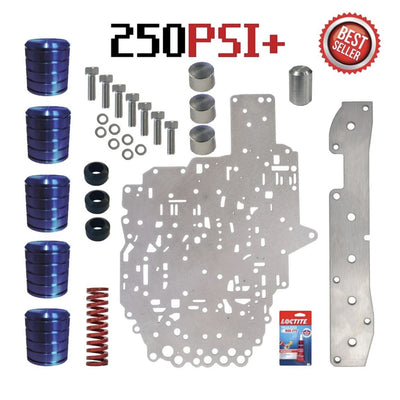
That stated, are you ready to become an expert on the “infamous” 68RFE transmission? The Chrysler 68RFE Transmission has been both a progressive leap and a plague to the 6.7L Cummins Community since 2007.5, when it became the successor to the staunchly supported 48RE Transmission.
The 48RE was based on the 727 TorqueFlite dating back to the 60’s and 70’s, making it a trustworthy asset; despite it’s unique imperfections. To become an expert on the 47RE or 48RE, check out our Transmissions 101 on the 47RE and 48RE Transmission here.

Our goal is to ensure that you, the reader, are as empowered with knowledge as possible on the 68RFE transmission and it’s unique needs. Whether you’re daily driving or drag racing, if you want to know more about the 68RFE transmission, this Drivetrain 101 is for you!
>>> View our 68RFE Transmissions & Parts Catalog Here!
In this Drivetrain 101, we will be addressing:
- The most popular failures we witness on the 68RFE transmission
- Its capabilities in reference to TCM tuning and shift/lockup protocol modification
- The strengths (believe it or not, there are a few!) of this transmission
- Resources for relevant updates and upgrades
And much, much more!
Chrysler 68RFE Transmission Product Resources:
- 68RFE Transmissions
- 68RFE Torque Converters
- 68RFE Rebuild Kits
- 68RFE Valve Bodies
- 68RFE Parts
Popular Transmission Information Resources:
- Top 5 Benefits of an Upgraded or Built Transmission
- Calculating Torque Multiplication Factor, Why is it So Important?
- Top 5 Ways to Extend the Life of a Factory Transmission
A Brief History of the 68RFE Transmission:
The 68RFE transmission came to the market at a time when the Ford 5R110 was mid-swing, and the 6R140 was just an idea gaining locomotion. On General Motors end, the 6 Speed Allison was well in effect, and the LMM DuraMax had just come forth as a more emissions-compliant LBZ. This meant that Dodge, per usual, was playing a game of catch-up with their outdated and inferior drivetrain technology.
>>> View our 68RFE Transmissions & Parts Catalog Here!

Coarsely, the 68RFE transmission arrived at 2007.5 controlled by a stand-alone TCM mounted to the passenger side of the trucks firewall. This maintained until Model Year 2010 where they converted to not only the “4th Generation” body style, but also a joint PCM system that circumnavigated the necessity for a stand-alone control module for the transmission. The following year, in 2011, it became obvious that the material used to manufacture the pumps and valve bodies (an extremely soft aluminum) was dying expeditiously and contributing to a surplus of warranty calls to Mopar.
Naturally, Mopar heard the inbound news of warranty calls and jumped into action to make a marginally less cheap product (let’s be real here) by anodizing the casting itself to prevent the complication of bore wear over time. In fact, we have an entire Transmissions 101 on this specific topic. It can be seen here:
Drivetrain 101: The 68RFE Valve Body • Problems, Solutions & Upgrades

There was a benefit to this, it partially minimized crossleakage. That’s about it. We have tested and tested the anodized versus the non-anodized valve bodies and the conclusion is consistent and simple. In factory configuration, the anodized valve bodies appear to have all of the same issues as the non-anodized valve bodies. They just appear to wear more slowly.
>>> View our 68RFE Transmissions & Parts Catalog Here!
Fortunately, they did try to resolve the 68RFE transmission plaguing complications in 2019. Unfortunately, they did not properly resolve the problem. They completely re-engineered the pump and valve body to provide devout accumulation and control to the torque converter’s lockup clutch. That is all well and good-faithed, but it does not address the most prolific issues in this transmission, as we will discuss further below.
How the 68RFE Transmission Clutch Packs Work:
Every transmission has unique qualities in terms of how it calculates shift behavior, how it responds to solenoid inputs and more. The 68RFE transmission is no different. Something that is critical in understanding the 68RFE transmission is understanding it’s clutch application chart. For this purpose, we should examine this information below:
Reverse - Low/Reverse + Reverse
1st Gear - Low/Reverse + Underdrive
2nd Gear - 2nd Clutch + Underdrive
3rd Gear - 4th Clutch + Underdrive
4th Gear - Overdrive + Underdrive
5th Gear - Overdrive + 4th Clutch
6th Gear - Overdrive + 2nd Clutch

This is a very common configuration for a double overdrive torque converter style 6-Speed automatic transmission. As you can see, every gear consists of 2 clutch packs. This is because clutch packs are not associated with the specific moving gears (1, 2, 3, etc.) but rather different functions of the transmission; often including hubs, baskets and otherwise. In most transmissions, a combination of planetary assemblies/clutch packs must be activated in unison to generate the desired input shaft to output shaft speed ratio.
>>> View our 68RFE Transmissions & Parts Catalog Here!
To generate an arbitrary example that might make this easier to understand, imagine losing 4th, 5th and 6th gear. Based on the data above, it is only logical that the Overdrive clutch pack would be the clutch pack that was compromised, based on the gears effected and the clutch packs activated across those different gears. If Overdrive is only used for 3 gears, and all 3 of them are inaccessible, the probability is a failure of Overdrive.
This diagnostic logic can apply to virtually any transmission. The Overdrive clutch pack is a uniquely large failure-point in these transmissions, and is much of the reason we pioneered our groundbreaking 68RFE Cherry Bomb. That would include the Overdrive, Underdrive and Reverse sections of the input clutch drum to correct said failure.

68RFE Transmission TCM Tuning and Adaptivity Protocol:
As aforementioned, the 68RFE Transmission was seeking to take a direct (and poorly calculated) swing at the Allison/TorqShift market. This transmission needed to be electronically advanced and capable of thinking for itself. You can compare this to how Tesla automobiles are able to drive themself, and other automotive manufacturers are playing catch-up to the technology. Allison was a leader in adaptive shift technology from the beginning, and this was Mopar finally getting on-board.
The issue is simple, the 68RFE Transmission was not advanced enough in it’s logic to actually make good decisions about shift timing and driving dynamics. As a result, the transmission suffers from a perpetual case of confusion. Does it want to lock or unlock the torque converter? What gear does it want to be in? How much line pressure does it want at this time? The only solution to these wildly sporadic variables is TCM Tuning.
>>> View our 68RFE Transmissions & Parts Catalog Here!

There are countless aftermarket products that function as “plug and play boxes” that increase line pressure artificially. We have gone to great length to understand how all of these products work, and have discovered that they all work very similarly. They are compilations of resistors and logic gates that are used to "spoof” the transmission into certain patterns of behavior.
*Pro-Tip* - Looking for a safe way to close internal crossleaks and capacitate higher line pressure at the clutch packs? One of the smartest and easiest transmission upgrades for the 66RFE transmission is a valve body. Consider an air-tight and ultra-fast shifting valve body from Next Gen here; a very noticeable improvement.
These devices are not a safe way of increasing line pressure and should be avoided. The most endorsable tuning platforms (and we aren’t getting a penny to say this) are EFI Live and EZ Lynk for the 6.7L Cummins in our opinion. They both prove to be excellent systems for implementing high quality TCM tuning under the tutelage of a qualified tuning professional. The internal formula that the truck uses to understand line pressure is the same as the formula for slope-intercept form:

- Y represents the line pressure commanded based on the calculations to the right side of the equal sign.
- M represents the factor of gain, a variable used to correlate engine load to line pressure demands. Tuners adjust this figure to increase line pressure.
- X represents engine load, a factor used by the on-board computers to process and understand resistance as applied to the torque of the motor.
- B represents a baseline of minimum line pressure figures to be commanded in any forward gear.
>>> View our 68RFE Transmissions & Parts Catalog Here!
When talking about TCM tuning and adaptivity protocol, it is important that we discuss clutch volume indexes, also known colloquially as “CVI’s”. CVI’s are a metric of time rational to apply piston travel distance. This unit of information is used to understand remaining tridimensional clutch volume based on the application times of clutches as pertaining to when their respective solenoid was energized and the circuit was completed; giving a signal of electrical continuity back to the on-board TCM.
The TCM then uses binary logic as well as Boolean to assess which solenoids are on and off, as well as which logical decisions the on-board computers that control the transmission will then make. Simpler worded, the longer clutches take to come on, the less friction the 68RFE transmission’s control module assumes are left on the clutches themselves. Based on this information, the transmission will retard or progress solenoid timing accordingly to enhance shift behavior. Below is a list of average CVI ranges as dictated by the Automatic Transmission Rebuilder’s Association:

Compiling all of this information, you should have a far strengthened idea of how the 68RFE transmission brain works. It is all too common that transmission experts process to the mechanical and hydraulic side of the trade, leaving little regard for the electronics that tie it altogether. In continuum, we will now address, in no specific order, the critical components of the 68RFE transmission and their problems, solutions and upgrades. Although we offer further reading on each of these components, we will be answering these 3 questions for each critical component:
- WHY does it break?
- HOW do I prevent it from breaking?
- WHAT can I put in it’s place to make it stronger?
>>> View our 68RFE Transmissions & Parts Catalog Here!
Problem #1 - The Torque Converter
The 68RFE Transmission Torque Converter is actually very capable in some ways. It has a giant stator (the strongest of the big 3, believe it or not!) and a double sided friction element, stock. This makes it a viable contender in factory form when held against it’s direct competition.
Unfortunately, it has countless ailments. It cannot hold the power of a deleted and tuned truck, even on it’s most gentle tune. It may survive, but it’s only temporary and physics are against you. The stator sprag itself tends to fail, as is common in some Dodge converters. This is caused by it’s inferior retainer that can be upgraded in an aftermarket torque converter like our 68RFE Project Carbon™ Billet Triple Disk Torque Converter.
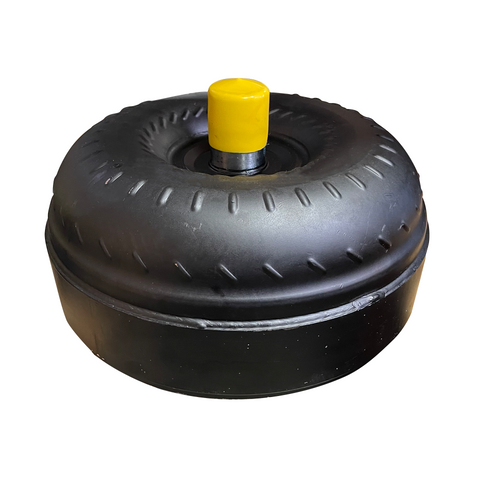
These torque converters also have unnecessarily high stall speeds. This is a testament to Mopar’s submission to emissions regulations and is not based in any functional or practical logic whatsoever. The solution here is to minimize friction inside the torque converter by opening up the fins on the stator itself. This decreases stall speed, allowing torque to safely reach the ground efficiently. Many people report this as a “power gain” sensation, but it’s actually an illusion. The truck is simply restoring lost torque that was not reaching the ground in the factory torque converter, which is ample and parasitic.
Problem #2 - The High Pressure Oil Pump
The 68RFE transmission has a very unique pump design, featuring 3 pump gears rather than the standard 2. The purpose of this was to help the 68RFE transmission produce line pressure quickly, reliably and efficiently. The good part about this design is that it is indeed quick and efficient!

The problem however, is reliability. This pump very quickly hollows it’s bores and begins to crossleak just like the valve body. There’s a lot that goes into why the pump fails, but we will address the largest points as follows:
- The Central Pump Gear wears out aggressively, causing oil reversion issues.
- There is a little-known drainback circuit of the pump that should be closed off to negate this concern, permanently.
- The inner valvetrain of the pump needs completely redesigned in the interest of longevity. The valves are made heavily of Magnesium (Mg) and Nickel (Ni), two elements that are violent when held inside a bore made of Aluminum (Al).
- The accumulator piston for the TCC tends to bottom out against it’s retainer during application of the converter clutch. This can be resolved by recalibrating the accumulation system of the pump with different hardware.
>>> View our 68RFE Transmissions & Parts Catalog Here!

Another data point worth understanding is that the 68RFE transmission oil pump functions as the valve body of the torque converter. They go hand-in-hand, and when one fails, often does the other. Our 68RFE Project Carbon™ High Pressure Oil Pump conglomerates all of these critical modifications into one, and is a good platform for transmission builds where there is question to the health or capability of an OEM pump.
Problem #3 - The Input Shaft
The 68RFE transmission Input Shaft is a very straightforward part of the equation. It is responsible for collecting all of the power exiting the torque converter and delivering it to the 68RFE Input Clutch Hub. The issue here is rather easy to guess, the factory input shaft was never meant for aggressive use. In fact, it was barely meant for factory use. The 68RFE transmission Input Shaft is an inflated version of the 545RFE Input Shaft. In fact, we’ve placed a picture of a Billet 545RFE Input Shaft below, does it look familiar?

The 68RFE transmission input shaft is immediately disadvantaged from power and performance every bit as much as it’s disadvantaged from towing and the very powerful lockup act of a billet triple disk torque converter. It’s made of a soft steel alloy with poor tensility and tremendous yield. The OEM input shaft is not necessarily all for loss, it is very safe to use at modest power levels. It’s even standard in some of our more entry level transmissions like our Xtreme Tow™ 68RFE Transmission. The issue is that once you begin to offer big expectations, the factory shaft simply cannot suffice.
>>> View our 68RFE Transmissions & Parts Catalog Here!
The next logical step forward is a 300M Billet 68RFE Transmission Input Shaft. These become necessary for anyone who plans to boost launch, tow heavy, add substantial amounts of power or simply want to invest in safety and longevity. We see these input shafts surviving up to about 900HP reliably, but have seen multiple successful examples at higher figures. For anyone in excess of 850HP, we recommend the Maraging Steel 68RFE Transmission Input Shaft.
Problem #4 - The Input Clutch Drum
The 68RFE transmissions input clutch drum is a complex compound component with multiple different purposes. In fact, all gears use at least one of the clutches inside the drum. The 68RFE transmission input drum consists of (from front to back) Reverse, Overdrive and Underdrive. It is built foundationally on a large reluctor wheel that speaks to the Input Shaft Speed Sensor. This reluctor wheel is known as the “Input Clutch Hub” and is often replaced with a billet piece in high power applications. Below is a picture of a Billet 68RFE Input Clutch Hub.

This drum has multiple ailments. The first is that it flexes outward due to a force of physics known as “centrifugal inertia”. This is the same force that allows you to spin in circles while swinging a bucket full of water and the water will remain inside the bucket as long as you are spinning rapidly enough. This is resolved by multiple different means, but most popularly the patented bolt-on Overdrive/Reverse Piston of the Sonnax 68RFE Smart-Tech Drum.
>>> View our 68RFE Transmissions & Parts Catalog Here!
It also lacks the amount of clutch volume necessary to safely activate the Overdrive clutch pack. The 68RFE transmission Overdrive clutch pack is comprised of 0.051” (that’s not a joke, they’re really that thin) thick clutches that are trapped in a hot, dysfunctional and highly restrictive drum. Although there is too much data to rationally include in this article, we can state that every 68RFE transmission we manufacture sports a completely re-engineered Overdrive section. This is commonly accepted to be the largest Achilles Heel of this transmission, and we do not offer a stock Overdrive stack-up in any of our built 68RFE transmissions.
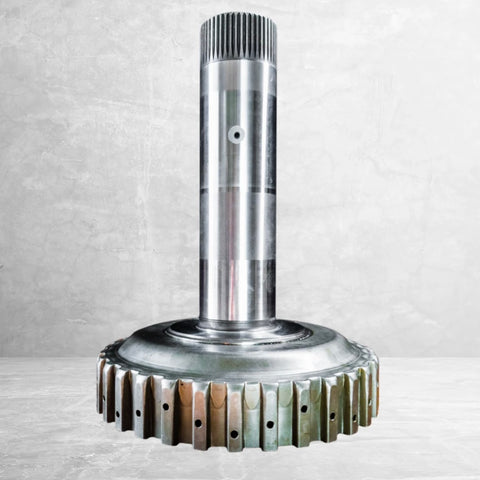
A final and equally valid ailment to the 68RFE transmission input clutch drum is it’s Overdrive hub. The Overdrive hub (pictured above) is the splined portion that the Overdrive clutches sit upon. During the 3-4 Upshift, this hub is synchronized in speed to the input shaft against the mass of the truck. The issue here is that it microfractures and fails the exact same way an input shaft does. In addition, if you perform the 3-4 upshift with the torque converter’s lockup assembly engaged (as tuners often do), you will be putting incredible load on this specific component. As a result, an Extreme Duty 68RFE Overdrive Hub should always be used for befitting applications.
Problem #5 - The Center Support
The center support of the 68RFE transmission is very unique. Any gear (except low ranges) that are overdriven OR underdriven must use at least one of the two clutch packs inside the center support. The center support houses 2nd Clutch and 4th Clutch and resides directly behind the input clutch drum assembly. It should be noted that these 2 clutches directly correspond with planetary assemblies that conflict with one another in final drive ratio. As a result, these clutches cannot apply over one another without one being forced to “win.” These clutches should never attempt to apply simultaneously.
These clutches seldom fail, but when they do, it’s often the cause of internal valve body crossleakage (as will be discussed later in the publication) or the culprit of tremendous power increase. Fortunately, we address both of these in our 68RFE Transmission Rebuild Kits and other complete transmissions. Although there are many ways to absolve this issue, adding clutches to the center support assembly is a safe way to increase torque capacity.
>>> View our 68RFE Transmissions & Parts Catalog Here!

These Center Supports also tend to fail or wear excessively inside, sometimes necessitating their complete replacement. For further information on our center support, try reading about our 68RFE Project Carbon™ Center Support Kit. Billet steel options are available for customers seeking especially high performance alternatives.
Problem #6 - The Low/Reverse Drum
Fortunately, the 68RFE Transmission Low/Reverse Drum is a generally powerful and durable system. However, there is one major failure point within this component that is worth understanding. This failure point is known as the “Low/Reverse Sprag”.
>>> View our 68RFE Transmissions & Parts Catalog Here!
The Low/Reverse Sprag is a “roller clutch” style component that is prone to physically cracking or breaking apart in the back of the transmission as a result of shock. The roller braces inside the sprag are made of plastic (seriously) and cannot withstand virtually ANY level of shock. Boost launching is the number one culprit of failure here. A common rule of thumb here is simple, if you plan to be boost launching, plan for the 68RFE Project Carbon™ Low/Reverse Sprag.

Sprags are nothing new. In fact, they date back over half a century in the automatic transmission world. Historically, sprag solutions have included but not been limited to: Welding the sprag in place, bolting it into the case and more. These are all implausible due to the location of the sprag inside the 68RFE transmission; being placed between two critical oil galleys. Our only option is to employ a stronger alternative.
Problem #7 - The Valve Body
There is no more talked about topic in the 68RFE transmission community other than it’s hellacious valve body. In fact, it was such an ardent topic of discussion that we did our own Transmissions 101 publication on that topic individually, it can be seen here! We will address the wave tops here however.
Much like the 68RFE transmission's High Pressure Oil Pump, the valvetrain is manufactured from low quality and aggressive metals that are very unwelcoming of their intended applications. The valve body is simply no different.
>>> View our 68RFE Transmissions & Parts Catalog Here!
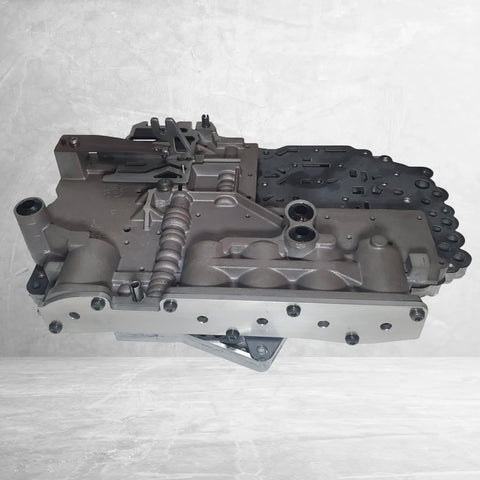
In fact, it is worse by all applicable metrics. We’ve tested brand new 68RFE transmission valve bodies in the past simply for data and discovered that they all have noticeable crossleakage straight from the factory! The amount of crossleakage often approached 2-3” of vacuum pressure. This is not enough to negate the function of the valve body, but it’s certainly not perfect.
Using our comprehensive understanding of the 68RFE Transmission Valve Body, it’s leaky valves, accumulation system, separator plate and other immense shortcomings, we can go back to the drawing board and use this knowledge to design a truly greater product. This is why we are so proud of our 68RFE Valve Body lineup! Alternatively, our best-selling Project Carbon™ 68RFE Valve Body Upgrade Kit is an amazing way to patch all of these issues for a fraction of the cost.
>>> View our 68RFE Transmissions & Parts Catalog Here!
Tip: Help to avoid premature bore wear, service the transmission regularly using our 68RFE OEM Filter & Gasket Service Kit!

Problem #8 - The Electronics
Automatic transmission electronics are always a dicey subject. The issue here is actually not the factory, but the opposite. The aftermarket is notorious for trying to save money by manufacturing cheaper electronics overseas or insourcing them from third party manufacturers. The issue here is that most manufacturers are smart enough to patent their own electronics, preventing the aftermarket from properly replicating their quality.

Although this is not necessarily an industry standard, Next Gen Diesel includes the electronics of the transmission itself in our 2 year, unlimited mile warranty. As a result, we must compile data on the most probable failures as well as the most successful solutions available for this transmission.
>>> View our 68RFE Transmissions & Parts Catalog Here!
What we have discovered time and time again, is that true OEM electronics such as the 68RFE Mopar OEM Updated Solenoid Pack are the only viable options for a successful transmission rebuild.
Problem #9 - The Bushings (Seriously!)
It’s not common that bushings make their way onto a list of anything, but we didn’t make this list to go “easy” on the 68RFE transmission. Hence, we must assert the inferior factory bushings. The OEM bushing design is a very cheap and outdated Babbitt material that is commonplace in the diesel world, but has been long since forgotten in other parts of the drivetrain engineering industry.
The reason behind this is that Babbitt bushings, by design, do not live very long. They tend to have a serviceable lifespan of about 150,000-200,000 miles in average “peak of the bell curve” applications. For roughly double the cost, the upgrade to Bronze bushings can become questionable. However, if we observe some basic scientific facts, we will discover the solution is right in front of us.
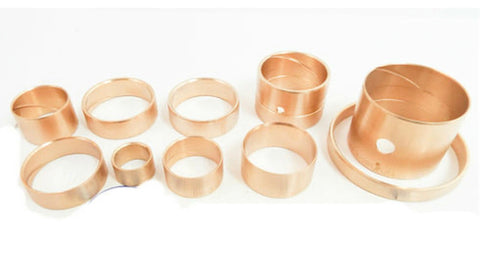
Bushings inside an automatic transmission have two enemies; One is heat, the other is oil contamination. Bronze is virtually impervious to both. The bronze is strong enough to weather the effect of oil imperfections with minimal impact. As for heat, Bronze saturates (begins the process of changing state from a solid state of matter to liquid state of matter) at 1,742 degrees Fahrenheit @ 14.7PSI of barometric pressure (sea level). The long and the short of that is simple, you aren’t hurting bronze bushings, spend the extra $40. You’ll thank us in the future.
>>> View our 68RFE Transmissions & Parts Catalog Here!
Problem #10 - The Oil Pan
The factory transmission oil pan was designed to accomplish one thing and one thing only, save money. This pan is stamped from a heated up sheet of steel that isn’t strong enough to withstand any level of shock or maltreatment. The pans are also incredibly shallow, barely even allowing the factory filters to function properly.
This is an objectively horrible decision and does not contribute to the longevity, health or operation of the transmission. Something to take into consideration when considering a deep transmission pan is the added time between transmission service intervals. Adding 20-30% more oil extends the amount of time between transmission services by a roughly similar figure. The same logic also applies to heat.

Added benefits of an aftermarket pan include the implementation of a drain plug. This makes the act of servicing your transmission extremely fast, easy and clean. The factory pan does not come with any of these benefits, leaving it the least qualified option of any. A 68RFE Transmission Deep Transmission Pan should be among your first considerations when upgrading this problematic transmission.
>>> View our 68RFE Transmissions & Parts Catalog Here!
Problem #11 - The Flexplate
Flexplates are a very misunderstood part of the drivetrain equation. It seems as though the only discussion to be had in the flexplate market is how to make them not break. Although it is important to have a sturdy and well-balanced flexplate, the flexplate serves a greater purpose.
Think of the flexplate as a giant shock absorber for the torque converter. Inside the torque converter is a tremendous amount of pressure, that only has the ability to exit between the OD of the input shaft and the ID of the oil pump’s stator support. If you’re running an OEM pump, you’re already at a deep disadvantage.

The solution is a well-balanced flexplate that meets SFI approval standards. However, it must also be a flexplate that is not unnecessarily bulky or thick. This is a Pyrrhic victory (a greater loss than win in effect) because excessively large flexplates do not have the versatility or flexibility to actually suffice their desired purpose. As a result, the intermediate stiffness of our SFI Approved Billet Flexplates as well as their incomprehensible strength make them trustworthy proponents of a healthy and successful transmission build.
>>> View our 68RFE Transmissions & Parts Catalog Here!
Frequently Asked Questions about the 68RFE Transmission:
Q: Is the 68RFE a good transmission?
A: Known as one of the most unreliable transmissions of all time, the Chrysler 68RFE is a fertile breeding ground for a variety of problems. This includes but is not limited to: Valve body crossleakage, burnt overdrive clutches, runaway torque converters, broken sprag assemblies and much more.
Q: Is there TCM Tuning for the 68RFE transmission?
A: Yes! The 68RFE can be easily tuned to request higher line pressure, different shift points, different lockup protocol and various other functional changes.
Q: What is the lifespan of a 68RFE?
A: Although there are many variables, the 68RFE transmission lasts an average of 120,000 to 150,000 miles in unmodified trucks with average applications. Trucks with larger tires, tuning, emissions delete systems and other aggravating factors usually fail much sooner. Transmissions with religious maintenance routines that are used largely for highway miles can last longer in some cases.
Q: What is the best upgrade for a 68RFE transmission?
A: The single most important upgrade someone can perform on a 68RFE transmission is a valve body. The valve body is where the overwhelming majority of their problems begin, and can yield huge benefits to any application. All 68RFE transmissions, regardless of application, should have one of our upgraded valve bodies.
Q: What are the service intervals of a 68RFE transmission?
A: It is our advice that this transmission is hot-flushed and a complete fluid and filter change is executed every 25,000 miles on average. Extraordinary applications may want to perform these services more frequently, whereas highway exclusive applications can safely push a bit further between services.
Conclusion to the 68RFE Transmission:
Since 2007.5, there’s been endless talk about the 68RFE transmission. It has been a never-ending conversation about what works, what doesn’t and why. No two trucks are identical, and nor should be two 68RFE transmissions. However, with the data compiled above, you should be well on your way to making an educated decision as to what 68RFE transmission or parts are right for your application. To learn more, click here or call and talk to one of our experts!






Comments (18)
Have2016 68rfe was putting at 20 mph put my foot in it lightly an now dose not do anything or make any noise any help were I should go or look
Great article! I have a 2012 3500, sitting at 329,000 miles , and no issues with 68rfe yet! I pull campers, 20k goosenecks, fuel trailers, boats ,steep mountain grades,you name it. Truck has had 37 Toyo mts since 100k and deleted since then too. Only upgrade to tranny was the H&S tranny tune. Treat her right, and she will do the same!
hello. I recently have a ram 2500 automatic transmission. year 2007 with a cummins 5.9 diesel. and the transmission only works the first 3 speeds. When leaving the vehicle for 2 days without working, the transmission oil level goes down in such a way that the oil dipstick does not show anything. After starting and moving the vehicle in first gear, the oil level on the dipstick marks where it should be.
I was towing a 7200# camper on vacation in Utah and Arizona when the trans just fizzeled and died. It wouldn’t shift out of 1st or 2nd and was losing ability to move. The fluid smelled burnt and I had to be towed to University Auto Repair in Flagstaff. The shop manager and I talked and he knew of a trans rebuilder in this area that rebuilt transmission for long haul pickup drivers doing delivery work across country. We along with the rebuilder agreed that, what they called, a stage 2 rebuild should be good enough for my towing usage and give me better performance and life. The truck only has 97000 miles on it so the failure was a shock to me. I had already put a secondary B&M cooler with fan on it and a Mag Hi-Tech deep trans pan on. Running Royal Purple trans fluid I’ve always babied the truck changing fluids in shorter intervals that mother MOPAR requested
I hope I’m making the right decision as the truck should last me for many many more RV towing miles.
I am getting a new tranny for my truck here in AZ at the dealership and a reman tranny is what they say to replace at 27K miles. I was going to opt for a new one and pay the difference about 2k $. What is the cost of the 68RFE upgrades you have shown?, and should I just save my money and put it toward a built one with these upgrades you have shown?
I wish I read this before getting my RAM 3500 ! 45,000 km (not miles) and transmission problems…..
I’ve got a 08 6.7 Cummins I ran on German Autobahn for 5 years. Deleted and tuned. Didn’t have a problem one. I brought it back to states and ended up with torque converter slip code. I’m in Alaska. And, 100% DV. I can’t afford a new truck or a trans that costs as much as a new truck. I have a badass truck with a XRT tuner. What will it cost me to get a kit to bring it back to life. With out taking it to a dealer to relearn. I know I can teach a monkey to rebuild it. So, it should be easy for myself as well.
I’ve seen some outrage prices. But, like I said I’m 100% DV on a very tight budget. But, if I’m going to build it. I’m building right the first time.
Great article! Very in-depth explanation of how the 68RFE functions and it’s main weak points! Great job!